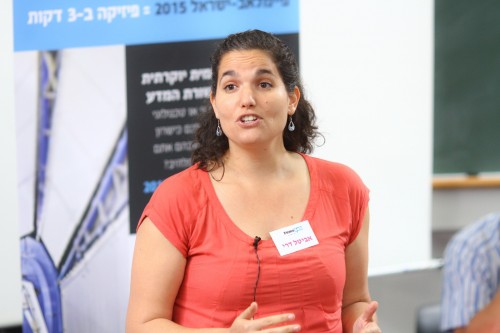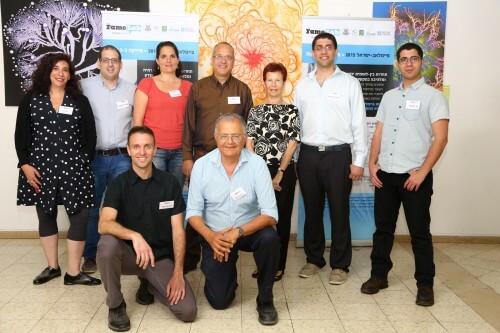Investigates the neutrino particles absorbed by the ICECUBE experiment in Antarctica * The finals of the FeyLab competition took place tonight (Thursday) at the Hamada Center in Tel Aviv, in collaboration with Hamada, the National Academy of Sciences, and the British Council * This was the seventh FeyLab competition, and all of them were won by female scientists

Avital Dari, a doctoral student in the group that studies the theories of particle physics at the Weizmann Institute, is the winner of the Israeli final of the FeyLab competition, in which scientists explain science to the general public in three minutes. Derry is the seventh winner. In all six previous competitions as well, female scientists won a prize - a trip to the Cheltenham Science Festival in Great Britain and participation in the finals of the global FeyLab competition.
Contestants in the competition, bachelor's and master's degree graduates dealing with physics, who are required to present a scientific topic to an audience in 3 minutes in an exciting, precise and clear manner. Usually the topic is free, but this time the competition was dedicated to the field of physics, to mark the 60th anniversary of the CERN particle accelerator in Geneva and on the occasion of Israel joining this year as a full member of the European Research Center in Geneva and special for physics lectures. The competition is organized by the Israeli National Academy of Sciences with Hamda - the center for scientific education in Tel Aviv. Because of this, of course, all the participants this year were physicists, including, of course, the five finalists.
This year's judges were Prof. Yoram Rosen from the Faculty of Physics at the Technion, Associate Prof. Ayelet Baram Tzbari, a science communication researcher from the Department of Science Teaching at the Technion, and the journalist Aviv Lavi (GLC).
Dari explained to the audience what the neutrino particles are: "All the time a flux of a trillion particles per second passes through each of us. They are transparent to us and we are transparent to them."
The Austrian physicist Wolfgang Pauli came across an experiment he conducted in 1930 in which the energy balance apparently violated the law of conservation of energy. Because of this, he predicted the existence of a particle that takes some of the energy with it and calculated its properties, however these properties - the almost complete absence of contact with ordinary matter, will mean that it will not be possible to discover it. He bet on a case of champagne.
"I predicted the existence of a particle that no one would discover," he said and bet on a case of champagne, but in the end the neutrino was discovered experimentally by a team led by Frederic Raines, in 1956, in experiments at the "Savannah River" nuclear reactor. Pauli, who was still an active physicist, had to fulfill his promise by intervening.
"The neutrinos are elementary particles like, for example, electrons, but they have no electric charge. They move at the speed of light but penetrate any obstacle. The neutrinos do not maintain contact with matter except rarely, once in a lifetime a neutrino particle will move one atom in our body."
However, in order to increase the chance of measuring a neutrino encounter with normal matter, an experiment known as "IceCube" was set up in Antarctica, in which a cube with a length, width and depth of kilometers was enclosed in ice (a cubic kilometer), and inside it were sensors designed to detect the traces of such an impact on the ice. On average, every eleven such interactions are recorded, left behind by neutrino particles created in the Big Bang and making their way to the South Pole over 14 billion years. In a few years we will be able to build a picture of the first moments of the universe thanks to the most indifferent particles in the universe."
"We already have a picture of the universe when it was 370 thousand years old. Before that the universe was opaque to light but was transparent to neutrinos up to the first minus ten second. For the first 370 years, the neutrino particles moved freely while the light was closed. Thus neutrinos are the key to learning about what happened at the beginning of the universe before light.
In a conversation with the science website after the win, Derry said that she is now at the beginning of her doctorate. "I studied at the Hebrew University for a bachelor's degree in physics, after which I did a conversion and went to study music at the Academy of Music (classical music singer) and only after that I came to the Weizmann Institute for a master's and a third degree. I am interested in education, this year I taught a class for children in astronomy at the Weizmann Institute and lecture in school classes that come to the institute on particles. I think it's important."
How did you come to study the neutrino particles?
Derry: "I always knew that I was interested in the most basic science there is. After a course by my supervisor Yossi Nir in particle physics I realized that this is the field that speaks to me. This is a very aesthetic field in my eyes. It's fascinating to learn about the building blocks of the matter of space and to see how the smallest things like neutrinos connect to the biggest things like the big bang that are usually talked about in the context of astrophysics. This is a beautiful example of how the smallest connects to the largest. We learn from each other, we learn from the particles about the big bang and the expansion of the universe, and from things that happen in astrophysics, we learn about particles."
How do you explain that so far only girls have won the FeyLab competition?
"Already in the semi-finals, all my competitors were laughing that there is already a winner, there is no need to make all the fuss. I told them that until now all the winners were biological."

And Antarctica to the coldest place in Jerusalem - the laboratory of Ben Ohion, a PhD student at the Hebrew University who cools atoms using a laser to study the fundamentals of nature.
He illustrated that temperature is actually the movement of gas particles, which at room temperature move at a speed of a thousand kilometers per hour. To slow them down it is necessary to cool them down. Dedicated refrigerators are able to cool gases down to a temperature of minus 200 degrees, but even then their speed is too high. Therefore, he explained, he uses a laser that will damage the gas molecules that reach him and thus stop them and actually freeze them.
Elad Schleifer, a doctoral student at the Hebrew University, researches treatment methods for cancer tumors using protons instead of X-ray irradiation. This is because protons emit most of the energy when they collide with the target (the tumor) and less with the healthy tissues on the way. The problem is that such a device costs one hundred million dollars and only 48 hospitals in the whole world could afford to purchase it, therefore the research aims to reduce and simplify the device so that every hospital can use it.
Shleifer himself, who came to the research following cancer that was discovered in his brother's brain (and which luckily he recovered from), says that the equipment in Israel is not sufficient to carry out the research and he is forced to travel to laboratories all over the world to conduct the experiments: "We don't have powerful lasers and I have to travel to the sand to to do these studies - Korea, Italy, USA."
Lev Talor, who has a bachelor's and master's degree in physics from the Hebrew University in preparation for finishing his doctorate at Tel Aviv University and in preparation for traveling to a postdoctoral position in Germany, tried to answer the question of whether we are alone. In short, discoveries of many planets outside the solar system - in fact almost every star, and many of which are the size of the Earth and are in the habitable zone, there is a chance for the survival of life. He estimates that the equipment needed to detect life in nearby solar systems will be available in 10-20 years.
Amir Weizman, a bachelor's and master's degree in materials engineering at Ben Gurion University, deals with the development of materials and processes in the medical device industry, and works at Mikrotech.
The company develops a tiny sensor that is inserted into blood vessels and checks the local blood pressure in them by decoding the frequency characteristic of blood flow through the sensor's membrane. Listening to the sensor is done using a common ultrasound device. In this way it will be possible to detect in advance the risk of diseases such as heart failure, intraocular pressure and more.
After the lectures of the competitors, Prof. Elam Gross explained the reasons for the public interest in the Higgs particle in particular and in the activity of the axis accelerator in general.

5 תגובות
The Pauli physicist mentioned in the article is Wolfgang Pauli and not Linus Pauling - both contributed greatly to quantum mechanics and both won the Nobel Prize (Linus Pauling - twice)
PaymLab Israel channel
https://www.youtube.com/user/FameLabIsrael
Is there a link where you can watch last years competitions (or just selected lectures) online?
What a beauty. Well done!